8 ways to open virtual keyboard on Windows 10
The Win 10 virtual keyboard is a quite useful and necessary feature in some cases for Windows users. On-Screen Keyboard (OSK) was first integrated into Windows XP, and is still maintained today. It proves to be extremely useful when your hard keyboard is paralyzed, or your computer is suspected of being infected with a virus or keylogger.
This virtual keyboard is very intuitive, with a full set of standard keys, you can use a mouse or other pointing device to select keys or use a physical key or group of keys to move through the keys on the screen. . Below, Network Administrator will guide you in 8 ways to open the virtual keyboard On Screen Keyboard on Windows 10.
1. Open the virtual keyboard with the shortcut
Press the Win + Ctrl + O keys to enable or disable the virtual keyboard.
If your keyboard is broken, use the mouse to highlight the osk and copy it, then use the mouse to paste it into the Windows 10 search box.
2. Open the virtual keyboard on the Start Menu
Enter the keyword On screen keyboard into the Search box on the Start Menu or on the Taskbar and then press Enter to open the virtual keyboard On screen board on Windows 10. If your keyboard is broken and cannot enter text, see method number 5, Or ask someone to send you the word "osk" via messaging application, use the mouse to copy and paste into the search box.

3. Open the virtual keyboard from the Run command window
To open the virtual keyboard from the Run command window, follow the steps below:
Step 1: Press the Windows + R key combination to open the Run command window.
Step 2: On the Run command window, enter OSK (no need to capitalize) there and press Enter to open the virtual keyboard.
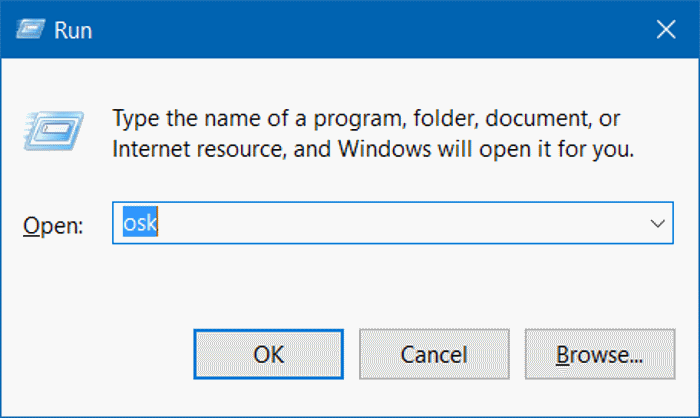
4. Open the virtual keyboard via Command Prompt or PowerShell
Follow the steps below to open the virtual keyboard via Command Prompt or PowerShell:
First open a Command Prompt window or PowerShell window, then enter "OSK" there and press Enter .
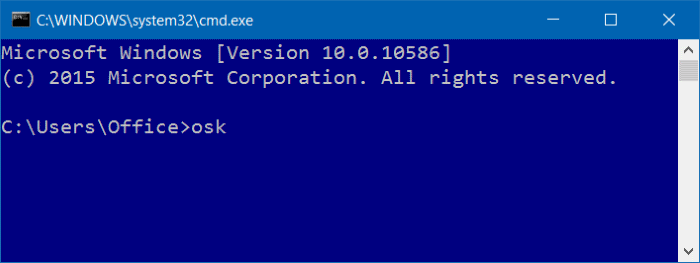
5. Open the virtual keyboard in Ease of Access via the Start menu
Open the Start Menu, then click All apps , then click the Windows Ease of Access folder icon to expand the folder, then click On Screen Keyboard to open the On Screen Keyboard virtual keyboard.
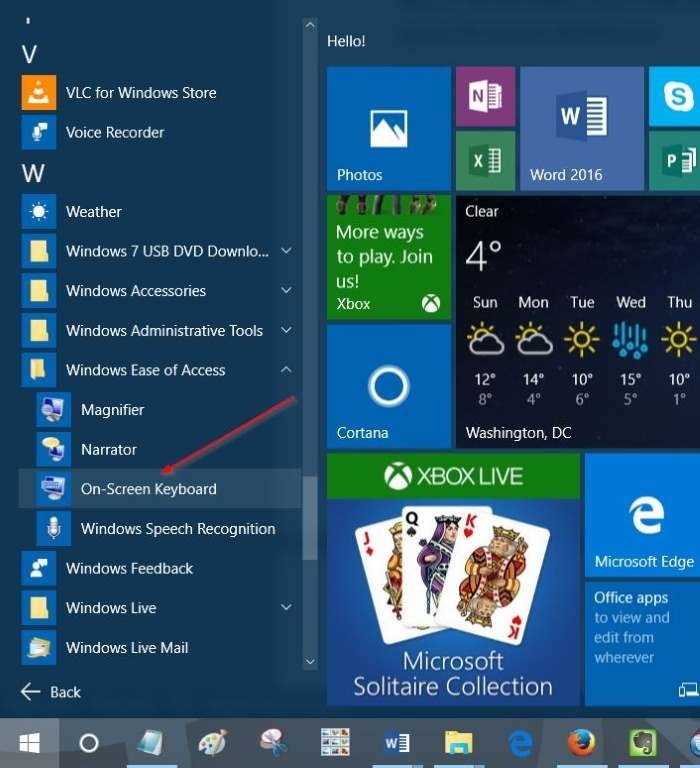
6. Use Ease of Access Center in PC Settings
Step 1: Open the Settings application by clicking the Settings icon in the left corner of the Start Menu.
Step 2: On the Settings window, find and click Ease of Access.
Step 3: Click Keyboard, then in the Turns on the on-screen keyboard section , change the option status to ON.

7. Open the virtual keyboard via Control Panel
Step 1: Open Control Panel by right-clicking the Start button , then selecting Control Panel .
Step 2: On the Control Panel window, find and click Ease of Access .
Step 3: Click on Ease of Access Center.
Step 4: Finally click Start On-Screen Keyboard to open the virtual keyboard.

8. Enable virtual keyboard every time Windows starts
From Ease of Access Center, click Use the computer without a mouse or keyboard , under Explore all settings .

Under Type using a pointing device , select the Use On-Screen Keyboard option , then click OK.

9. Open the virtual keyboard Touch keyboard on Windows 10
In addition to the traditional virtual keyboard found on all Windows, Windows 10 also has a built-in virtual Touch keyboard for touch screens. To open this keyboard, right-click on the taskbar > select Show touch keyboard button > a keyboard icon will appear next to the speaker icon. This keyboard has a built-in sticker. The special feature of the keyboard is that when needed, you click on the icon to use it. When not in use, you just need to move the mouse away, type from the real keyboard, the touch keyboard will be hidden.
If using on a touch device or using a phone or touch screen to remotely control Windows 10, you can go to Settings > Device > Typing > turn on the Show the touch keyboard not in tablet mode and there's no keyboard attached option. When you point your mouse over the text input area, the keyboard will automatically appear.
10. Configure the virtual keyboard
Once the keyboard is displayed on screen, you can adjust it to suit your needs by clicking the Options key on the virtual keyboard, in the bottom right corner. Here you have several ways to use the virtual keyboard:
- Use the Scanning Speed slider to select the scanning speed.
- Use click sound - Use this option if you want to hear a sound when you press a key.
- Show keys to make it easier to move around the screen - Use this option if you want the keys to light up as you type.
- Turn on numeric keypad - Use this option to expand OSK and display the numeric keypad.
- Click on keys or press Alt + C to access the keyboard with a mouse or other pointing device by clicking on the box you want to use.
- Hover over keys or press Alt + H to access the keyboard with a mouse or other pointing device, by moving over the box to select. You can choose the hover duration using the Hover duration slider .
- Scan through keys or press Alt + S to access the keyboard using access devices such as spacebar, switch or gamepad. Use this mode if you want OSK to continuously scan the keyboard. Scan mode highlights areas where you can enter keyboard characters by pressing a keyboard shortcut, using an input device, or using a one-click emulation device.
- Use Text Prediction or press Alt + T : Use this option if you want OSK to suggest words for you, to speed up typing and check spelling.
- You can also choose to add spaces to all selected words by clicking to select or pressing Alt + W .
11. How to pin virtual keyboard in Windows 10
1. Open the Start menu by clicking the Windows button at the bottom left of the screen.

2. Select Settings.

3. Click Ease of Access in Windows Settings.
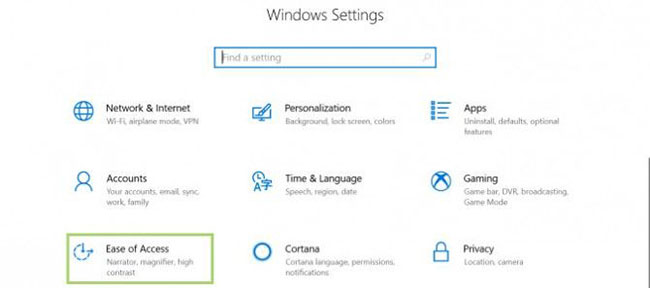
4. Select Keyboard under the Interaction heading .

5. Turn on the On button in the Use the On-Screen Keyboard option .

6. Click X to close the Keyboard dialog box. The virtual keyboard will stay in its place.
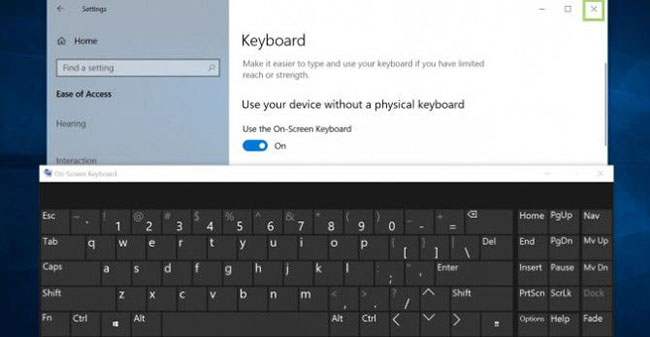
Refer to some more articles below:
Good luck!
You should read it
- How to get the most out of virtual keyboards on Windows 10
- How to open the virtual keyboard on Windows 10
- How to resize virtual keyboard/touch keyboard on Windows 11
- How to open virtual keyboard on Windows 10 for Laptop and PC
- How to fix the virtual keyboard automatically opens on Windows 10
- How to change the theme and background color of the Windows 11 virtual keyboard
- Steps to disable the virtual keyboard on Windows 10
- Fix virtual keyboard not working in Windows 10
May be interested
- How to open virtual keyboard on Windows 10, 11, 7
 virtual keyboard on windows 10, 11, 7 is an effective support tool in case the physical keyboard is broken or you want to enter information securely on your computer system, laptop, how to open the keyboard the fastest way is to press the windows + r key combination, enter the osk shortcut and press enter to finish.
virtual keyboard on windows 10, 11, 7 is an effective support tool in case the physical keyboard is broken or you want to enter information securely on your computer system, laptop, how to open the keyboard the fastest way is to press the windows + r key combination, enter the osk shortcut and press enter to finish. - How to open virtual keyboard with shortcut key, open On-Screen Keyboard quickly
 after a period of use, the computer keyboard may be faulty or some keys may be paralyzed. at that time, you can open the virtual keyboard with a shortcut key to replace it. with just two simple steps, you can quickly open the on-screen keyboard.
after a period of use, the computer keyboard may be faulty or some keys may be paralyzed. at that time, you can open the virtual keyboard with a shortcut key to replace it. with just two simple steps, you can quickly open the on-screen keyboard. - How to install Korean keyboard for Windows
 install korean keyboard for windows 7, 8, 8.1, windows 10, which will help you type korean on your computer. to set the korean language for you the key is quite simple, please refer to how to do it in this tutorial.
install korean keyboard for windows 7, 8, 8.1, windows 10, which will help you type korean on your computer. to set the korean language for you the key is quite simple, please refer to how to do it in this tutorial. - How to resize virtual keyboard/touch keyboard on Windows 11
 virtual keyboard (touch keyboard) a useful feature that many windows users have been using regularly every day. however, not everyone knows that the size of the virtual keyboard on the screen can be adjusted flexibly.
virtual keyboard (touch keyboard) a useful feature that many windows users have been using regularly every day. however, not everyone knows that the size of the virtual keyboard on the screen can be adjusted flexibly. - How to change the theme and background color of the Windows 11 virtual keyboard
 if you regularly use the windows virtual keys, you can make your experience new and more interesting by changing the theme and background color of the keyboard, bringing new and colorful looks.
if you regularly use the windows virtual keys, you can make your experience new and more interesting by changing the theme and background color of the keyboard, bringing new and colorful looks. - Steps to disable the virtual keyboard on Windows 10
 this article will show you how to disable the virtual keyboard that appears on the login screen in windows 10.
this article will show you how to disable the virtual keyboard that appears on the login screen in windows 10. - How to hide / show virtual keyboard button in Taskbar on Windows 10
 to open the virtual keyboard on windows you need to perform a few actions. therefore, it will be much faster if you show the button to activate the virtual keyboard right on the taskbar.
to open the virtual keyboard on windows you need to perform a few actions. therefore, it will be much faster if you show the button to activate the virtual keyboard right on the taskbar. - Fix virtual keyboard not working in Windows 10
 if the virtual keyboard stops working, you may be in for a bit of trouble. fortunately, there are some simple tips to fix the on-screen keyboard not working problem in windows 10.
if the virtual keyboard stops working, you may be in for a bit of trouble. fortunately, there are some simple tips to fix the on-screen keyboard not working problem in windows 10. - Disable Windows 10 keyboard in 5 simple ways
 for some reason you want to disable the keyboard on your windows computer. for example, you are watching an episode and you do not want someone to accidentally press the button on the keyboard and reload from scratch or reuse it. you can then disable the keyboard on your windows computer.
for some reason you want to disable the keyboard on your windows computer. for example, you are watching an episode and you do not want someone to accidentally press the button on the keyboard and reload from scratch or reuse it. you can then disable the keyboard on your windows computer. - How to enable virtual keyboard/touch keyboard on Windows 11
 if you are running windows 11 on a pc with a touch screen, the virtual keyboard will be a much-needed feature in case you want to use the device as a tablet.
if you are running windows 11 on a pc with a touch screen, the virtual keyboard will be a much-needed feature in case you want to use the device as a tablet.










 How to record Windows 10 screen with sound, without installing software
How to record Windows 10 screen with sound, without installing software Instructions for installing iTunes for Windows 10
Instructions for installing iTunes for Windows 10 How to fix Windows 10 can't sleep and won't turn on error
How to fix Windows 10 can't sleep and won't turn on error How to install Windows 10 64-bit UEFI standard - GPT
How to install Windows 10 64-bit UEFI standard - GPT How to start Windows 10 quickly, access Windows 10 at high speed
How to start Windows 10 quickly, access Windows 10 at high speed 2 How to change Windows 10 computer wallpaper
2 How to change Windows 10 computer wallpaper